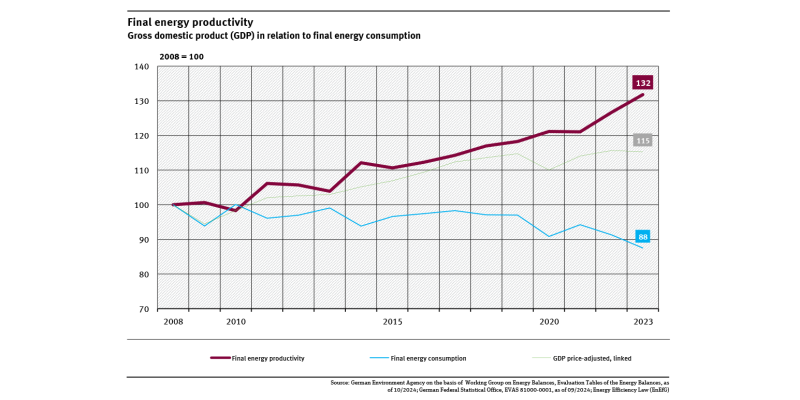Indicator: Final energy productivity
 Click to enlarge
Click to enlargeSource: German Federal Environment Agency on basis of the Federal Statistical Office of Germany and Working Group on Energy Balances Figure as PDF
 Umweltbundesamt
Umweltbundesamt
 Click to enlarge
Click to enlarge
- The efficiency with which an economy uses energy can be measured by the "final energy productivity" indicator.
- Between 2008 and 2023, final energy productivity increased by 32 %.
- Reducing energy consumption is more important than increasing energy productivity.
- The European "Energy Efficiency Directive" and the German "Energy Efficiency Act" set ambitious targets for reducing final energy consumption.
Energy productivity is a measure of how efficiently an economy, industry or society uses energy to generate economic value. It is calculated by dividing gross domestic product (GDP) by energy consumption. Higher energy productivity means that less energy is needed to produce a unit of economic value. This is an indicator of efficient and sustainable use of energy. Lower energy use is also good for the environment, as the energy system has a number of negative environmental impacts. Final energy consumption is used here as a reference value, so the indicator is referred to as "final energy productivity".
In the "Energy Concept" of 2010, the German government set itself long-term annual growth targets for final energy productivity. Today the focus of policy is on the absolute reduction of energy consumption. The European Energy Efficiency Directive and the German "Energy Efficiency Act" (EnEfG), which was passed in 2023, play a central role. This law stipulates that final energy consumption should be reduced to 1,867 TWh.
Final energy productivity rose by 32 % between 2008 and 2023. The main driver of the increase in productivity was the rise in gross domestic product, which grew by 15 % since 2008. Final energy consumption fell by 12 % in the same period. This so-called decoupling between economic output and consumption can be explained on the one hand by greater energy efficiency and on the other by a structural shift towards less energy-intensive economic activities.
In "Projection Report 2023 for Germany" (in German, with comprehensive English summary) scenario analyses were used to examine whether Germany can achieve its energy and climate targets in 2030: If all the measures planned by the governing coalition are implemented, the EEV is expected to fall by around 16 % in 2030 compared to 2008 (with-measures scenario). This would fall well short of the Energy Efficiency Act's target of reducing final energy consumption by over 25 % by 2030. Further measures to reduce the EEV are therefore necessary in order to achieve the targets of the Energy Efficiency Act.
The final energy productivity indicator is calculated as the ratio between gross domestic product and final energy consumption in Germany. The gross domestic product is calculated and published by the Federal Statistical Office of Germany as part of the macroeconomic accounts. Final energy consumption is determined by Working Group on Energy Balances (AGEB) on a regular basis. Explanations of the calculation methods are published in the Preface to the Energy Balances (pdf, in German only).
More detailed information: 'Energieproduktivität' (in German only).